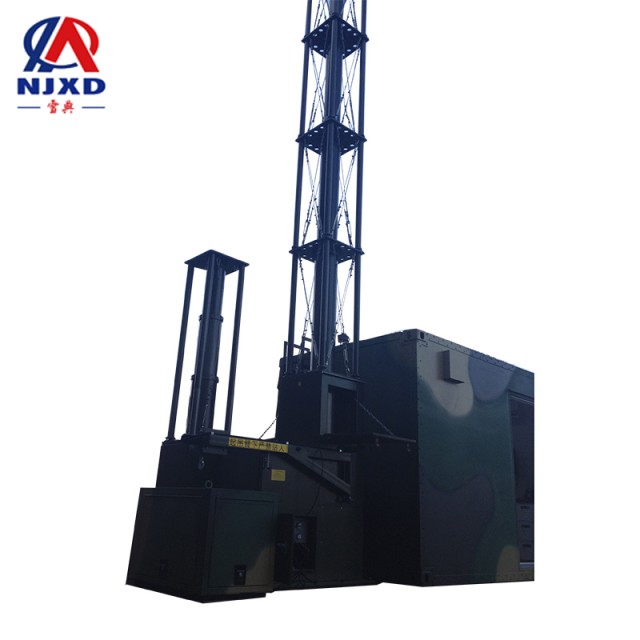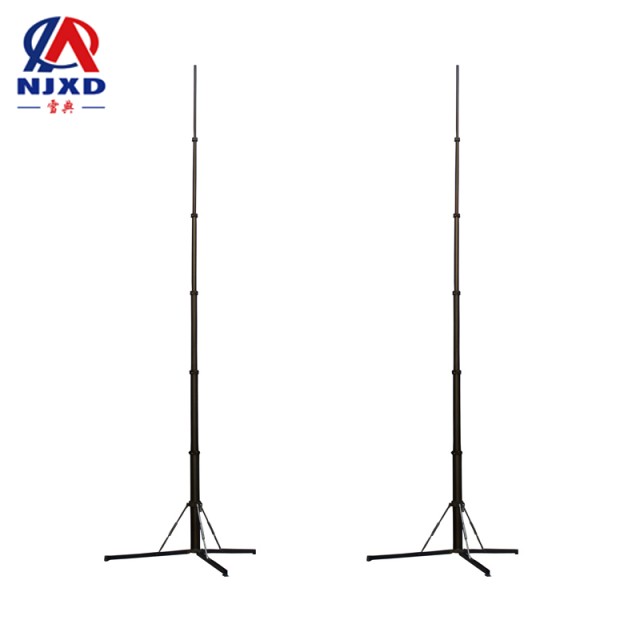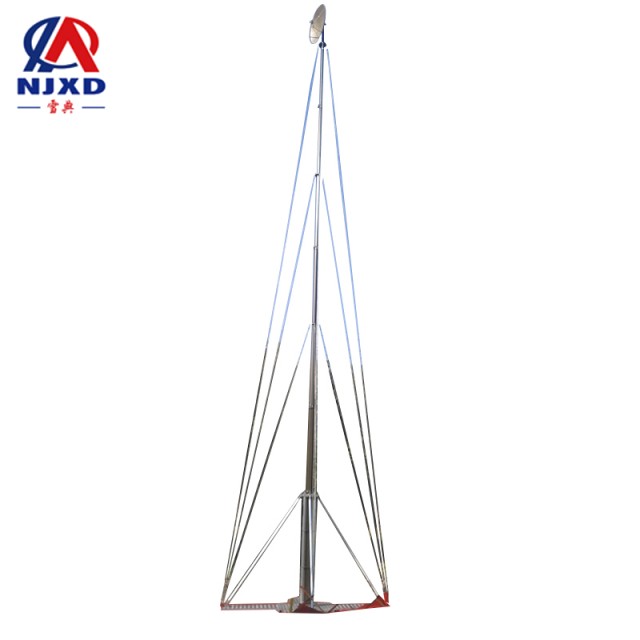NEWS
Basic interpretation of Reynolds number lifting bracket wind resistance
Time:2021-08-24 View:

Reynolds number (Reynolds number) is a dimensionless number that can be used to characterize fluid flow. Re = ρ vd/μ, where v, ρ and μ are respectively the flow velocity, density and viscosity coefficient of the fluid, and d is the characteristic length. For example, if a fluid flows through a circular pipe, d is the equivalent diameter of the pipe. Reynolds number can be used to distinguish the flow of fluid from laminar flow or turbulence, and can also be used to determine the resistance to the flow of objects in fluid. It can be used in telescopic mast.
Basic interpretation
Reynolds number is the number of similarity criteria for characterizing viscous effects in fluid mechanics. Named in memory of O. Renault, it is recorded as Re.
Reynolds number, also known as Reynolds quasi-number, is a non-factor number Group used to judge the flow state of viscous fluid.
1883 British Renault (O.Reynolds) the flow of the fluid in the circular tube was observed. Firstly, it was pointed out that the flow pattern of the fluid was not only related to the flow rate (ω), but also related to the pipe diameter (d) and the viscosity (μ) of the fluid., the density of fluid (ρ) is related to these three factors.
Re = ρ vL/μ,ρ and μ are fluid density and dynamic viscosity coefficient, v and L are characteristic speed of flow field and characteristic length. Reynolds number physically represents the ratio of inertia force and viscous force magnitude. For external flow problems, v and L generally take the far forward flow velocity and the main size of objects (such as wing chord length or ball diameter); For internal flow problems, take the average velocity and channel diameter in the Channel. The Reynolds number of two geometrically similar flow fields is equal, then the ratio of inertial force and viscous force of corresponding microgroups is equal.
When Reynolds number is small, viscous force has more influence on the flow field than inertia. The disturbance of flow velocity in the flow field will decay due to viscous force, and the fluid flow is stable and laminar flow. On the contrary, if the Reynolds number is large, the influence of inertia on the flow field is greater than viscous force, and the fluid flow is relatively unstable. Small changes in velocity are easy to develop and enhance, forming disordered and irregular turbulence flow flied.

Related research
The smaller the Reynolds number, the more significant the viscous force effect, and the greater the inertia effect. Flow with very small Reynolds number, such as the falling of fog beads or the flow process in lubricating film, is characterized by that viscous effect is important in the whole flow field. The flow with a large Reynolds number, such as the air flow relative to the plane when the plane flies near the ground, its characteristic is that the influence of fluid viscosity on the flow around the object is only important in the boundary layer of the object and the wake behind the object. In the flow where inertial force and viscous force play an important role, the flow that wants to make two geometries similar (geometric similarity ratio n = Lp/Lm, subscript p represents the real object, m represents the model) to meet the dynamic similarity condition, the Reynolds number of the model and the real object must be guaranteed to be equal. For example, if a simulation experiment is carried out in the same fluid (that is, P equals), the dynamic similarity condition is vm = nvp, that is, the model is reduced by n times, and the speed is increased by n times.
When an object moves on a constant plane in incompressible viscous fluid, all dimensionless numbers are determined by two parameters: angle of attack α and Reynolds number Re. In order to achieve dynamic similarity, besides requiring geometric similarity between the model and the real object, it is also necessary to ensure that the angle of attack and Reynolds number are equal. The first condition is always easy to achieve, while the second condition is generally difficult to fully meet. In particular, when the scale of the object to be flowed is relatively large and the model is many times smaller than the object, it is necessary to greatly change the velocity, density and viscosity of the fluid. This is very difficult in practice, because in the low speed wind tunnel, the increase of wind speed always has a certain limit. Therefore, the similarity law cannot be strictly satisfied and can only be approximately implemented. Of course, this will affect the aerodynamic characteristics, for example, the maximum resistance coefficient should be reduced, the minimum resistance coefficient will be increased, etc. However, as long as the difference between the real Reynolds number Rep and the Reynolds number Rem of the model is not large, some empirical methods can be used to correct it, so that the experimental results can still be applied in practice. Of course, the best way is to build a huge wind tunnel in which real planes can be blown, or a circular closed wind tunnel in which compressed air (with high density) acts, in order to plus-sized the Reynolds number of model test.
According to the theory of molecular motion, the dynamic viscosity coefficient μ∝ ρvˉ l, where v ˉ is the average velocity of molecules and l is the average free path of molecules. Since v and sound velocity c are of the same magnitude, it can be obtained: Re = kMa/Kn, where Ma is Mach number; Kn is KNU Zeng number; k is a constant; It indicates Reynolds number, there is an internal connection between Mach number and KNU Zeng number. When the flow velocity is very small, Ma is very small and Kn is also very small. Since viscous effect is the main, these two dimensionless parameters appear in the combined form Ma/Kn, that is, they appear in Reynolds number. When the flow velocity is very high, it can be seen from the dimensional theory that Reynolds number and Mach number both play an important role. If the air is thin, KNU once played a major role.
The solution of viscous fluid is not only related to boundary conditions, but also to Reynolds number. If the Reynolds number is small, the viscous force is the main factor, and the pressure term is mainly balanced with the viscous force term; If the Reynolds number is large, the viscous force term becomes the secondary factor, and the pressure term is mainly balanced with the inertial force term. Therefore, in different Reynolds number ranges, the fluid flow is different, and the resistance of objects is also different. When Reynolds number is low, resistance is proportional to velocity, viscosity and characteristic length; While when Reynolds number is high, resistance is generally proportional to velocity square, density and characteristic length square.
Reynolds number is also the basis for judging flow characteristics. For example, in pipe flow, flow with Reynolds number less than 2300 is laminar flow, and Reynolds number equal to 2300~4000 is transitional state, when the Reynolds number is greater than 4000, it is turbulent.

Typical Reynolds number
Ordinary airliner: 5 000 000
Small UAV: 400,000
Seagull: 100,000
Gliding butterfly: 7000
Round smooth pipe: 2500
Rubber pipe: 1600~2100
Sperm: 0.0001
Blood flow in the brain: 100
Blood flow in the aorta 1000

CATEGORY
NEWS
- Difference between maximum wind speed and maximum wind speed lift rod wind resistance
- Basic interpretation of Reynolds number lifting bracket wind resistance
- Portable lift rod canvas bag
- Wind energy density grade telescopic mast wind resistance and wind power generation
- Roller structure rotatable lift rod